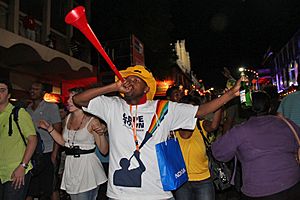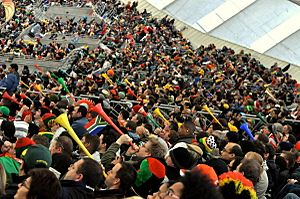Vuvuzela facts for kids
A vuvuzela is a special blowing horn. People often use it at soccer games in South Africa. Some people also call it a lepata or a stadium horn. To make a sound, you need strong lips and lungs. The sound is very loud, like a foghorn or an elephant.
Contents
Where Did the Vuvuzela Come From?
The first vuvuzelas were made from tin. They became very popular in South Africa in the 1990s. A soccer fan named Freddie "Saddam" Maake says he invented the vuvuzela. He got the idea from an aluminium 1965 bicycle horn.
How Freddie Maake Made It
Freddie took off the black rubber part of the bicycle horn. Then he blew into it. He thought it was too short, so he added a pipe to make it longer. Freddie has photos of himself at soccer games with his aluminium vuvuzela. He says people first thought the vuvuzela was a dangerous weapon. So, he looked for a plastic company to make it safer.
Plastic Vuvuzelas Become Popular
In 2001, a South African company called Masincedane Sport started selling plastic vuvuzelas. Neil van Schalkwyk, one of the owners, even won an award for his business in 2001.
Vuvuzela's History and Debates
Some people believe the vuvuzela has old roots in African history. But historians often disagree about this. Long ago, South African people would blow a kudu horn. They used it to call villagers together for meetings. There is also a South African saying: "A baboon is killed by a lot of noise." This shows how important loud sounds can be.
Similar horns have been made by many different cultures for a long time. For example, a horn that looks just like a vuvuzela appears in an old picture. It's called "The Dinner Horn" by Winslow Homer from the 1870s.
Vuvuzelas at Big Soccer Events
Vuvuzelas became famous worldwide during the 2010 FIFA World Cup. This was because blowing them at soccer matches was a normal thing in South Africa. At first, FIFA, the world football group, did not want to allow vuvuzelas.
Why FIFA Was Worried
FIFA was worried that some fans might use the vuvuzelas as a weapon. They also thought businesses might put ads on them. But the South African Football Association (SAFA) said vuvuzelas were a key part of South African games. So, in July 2008, FIFA decided to let them be used.
Complaints About the Noise
However, some football players and fans did not like the vuvuzelas. Lee Dixon from the BBC Three said the sounds were "quite irritating." European TV channels also complained to FIFA. They said they could not hear the commentators because of the loud noise.
Vuvuzela Problems and Bans
Vuvuzelas can be very loud. They can reach about 120 decibels (dB) from one metre away. Right next to the horn, it can be even louder. This high noise level has caused some problems.
Health Concerns and Earplugs
Some places have tried to stop people from using vuvuzelas. This is because the loud sound can damage hearing. Also, the noise might be louder than important safety announcements. During the 2010 World Cup, many people wanted earplugs to protect their ears. Pharmacies often ran out of them. Neil van Schalkwyk, who makes plastic vuvuzelas, even started selling earplugs to fans.
Vuvuzela Bans in Other Countries
After the 2010 World Cup, other countries started banning vuvuzelas. In Britain, Tottenham Hotspur was the first football team to ban them in July 2010. Many other teams have followed since then. They were banned for health and safety reasons. One main reason was that people might not hear important safety messages because of the noise.
Images for kids
-
Kudu vuvuzela blown by a N'anga in Zimbabwe in 1989
-
A 2010 FIFA World Cup crowd blowing vuvuzelas
-
Wesley Sneijder blowing on a vuvuzela
See also
 In Spanish: Vuvuzela para niños
In Spanish: Vuvuzela para niños








